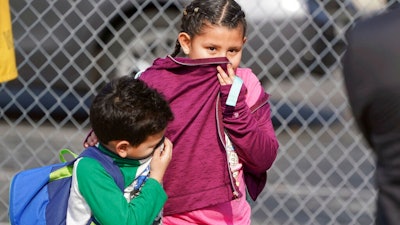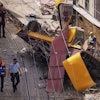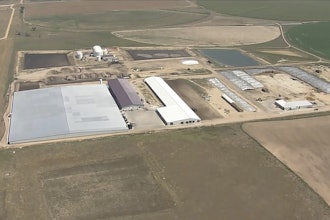
CUDAHY, Calif. (AP) — U.S. authorities will investigate why an airliner with engine trouble dumped jet fuel over a densely populated area near Los Angeles while making an emergency return to the airport, dousing dozens of schoolchildren in a smelly vapor.
Delta Air Lines Flight 89 to Shanghai, a Boeing 777-200 with 181 passengers and crew on board, turned back to Los Angeles International Airport only minutes after taking off Tuesday.
The pilot reported a compressor stall in the right engine — damage that can happen through malfunction or when a foreign object such as a bird hits an engine. The damage can reduce engine thrust or lead to a fire in the worst cases.
Planes can take off weighted down for their journey, but if they must land early because of an emergency, it can be necessary to dump fuel so that the aircraft is lighter to avoid damage.
Air traffic control asked the crew if they wanted to return to LAX immediately or linger over the ocean “to hold and burn fuel," according to a recording of the radio communications.
“We’re going to go ahead,” the pilot or co-pilot responds. “We’ve got it back under control. ... We’re not critical.”
“OK, so you don’t need to hold or dump fuel or anything like that?” the controller asks.
“Ah, negative,” the pilot responds.
But the plane did later dump fuel as it circled back across greater Los Angeles to approach the airport.
The fuel sprayed out in two streams from the wings and fell at midday in the city of Cudahy and nearby parts of Los Angeles County, about 13 miles (21 kilometers) east of the airport.
The vapor directly landed on three Los Angeles Unified School District campuses and about 20 others experienced some effects from the odor of fuel discharged at higher altitudes, the district said in a statement.
The fuel, described by fire officials as a vapor, caused minor skin and lung irritation to 56 children and adults but nobody was taken to the hospital and the only decontamination required was soap and water, officials said.
All the schools were cleaned overnight and reopened Wednesday.
Diego Martinez, a sixth-grader at Park Avenue Elementary in Cudahy, said he and his classmates were outside for physical education class when they saw the airplane flying low overhead. Shortly afterward, the air filled with the pungent odor of fuel.
“It was very strong, the odor,” the 12-year-old said.
Diego wasn’t doused but some of his friends complained that their skin was itching.
Some teachers at the school had headaches from the smell, said Antonio Buenabad, area representative for the United Teachers Los Angeles union.
Delta Air Lines said the aircraft landed safely after releasing fuel, “which was required as part of normal procedure to reach a safe landing weight."
The Federal Aviation Administration said it is investigating.
“There are special fuel-dumping procedures for aircraft operating into and out of any major U.S. airport," the FAA said in a statement. “These procedures call for fuel to be dumped over designated unpopulated areas, typically at higher altitudes so the fuel atomizes and disperses before it reaches the ground."
However, pilots can deviate from the rules in an emergency for safety reasons, said Doug Moss, a retired airline captain and owner of AeroPacific Consulting LLC, an aviation consulting firm in Reno, Nevada.
The pilot could have stayed over the ocean to dump his fuel but that could have taken at least a half-hour and up to an hour, Moss said.
He said that when there is a compressor stall, the crew can't determine how much internal damage was done to the engine, which could mean “an uncontrollable fire as a future possibility."
“He’s flying an airplane with a damaged engine that may be on fire," Moss said. “So he has to make the decision: Do I spend the time to dump fuel or do I put this thing on the ground as soon as I can? You're not going to kill anyone by dumping fuel.”
“There’s no dereliction of duty. Everybody’s trying to do the best they can, but it’s a fast-paced, dynamic ballgame, and there’s not a lot of time to think ... lives are at stake," Moss said. “He got it on the ground safely. Unfortunately, there was collateral damage. People got gas poured over them.”






















